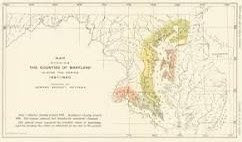Potomac County
Silas Hurry, HSMC Curator of Collections and Archaeological Laboratory Director, shares about another name for St. Mary’s County, Maryland.
 “Have you been to Potomac County, or Patuxent County? How about St. Mary’s County and Calvert County? For a short time in the 1650s, following the beheading of King Charles I, the Commonwealth Commissioners ruled Maryland and wanted to blot out any sign of the Calverts and their popish ways. Documents in the Maryland State archives from 1654 replace the names St. Mary’s with Potomac and created a new county called Patuxent which included what we now know as Calvert County and the western shore of the Patuxent River that is now in St. Mary’s County. At the same time, they refer to Anne Arundel County as Providence County.
“Have you been to Potomac County, or Patuxent County? How about St. Mary’s County and Calvert County? For a short time in the 1650s, following the beheading of King Charles I, the Commonwealth Commissioners ruled Maryland and wanted to blot out any sign of the Calverts and their popish ways. Documents in the Maryland State archives from 1654 replace the names St. Mary’s with Potomac and created a new county called Patuxent which included what we now know as Calvert County and the western shore of the Patuxent River that is now in St. Mary’s County. At the same time, they refer to Anne Arundel County as Providence County.
At the same time, the Assembly “updated” the Act Concerning Religion with the following language:
“That none who profess and Execise the Popish Religion Commonly known by the Name of the Roman Catholick Religion can be protected in this Province by the Lawes of England formerly Established and yet unrepealed nor by the Government of the Commonwealth of England Scotland and Ireland and the Dominions thereunto belonging.” – Archives of Maryland, Volume I page 341
So, who were the Commissioners pushing through these draconian changes? One of Commissioners was Richard Bennett who had led the Puritan settlers from the southside of the James River in Virginia to “Providence on the Severn” after Ingle’s revolt and the ensuing “Plundering Times.” Intriguingly the Puritans that had been persecuted in Virginia because of their religious affiliation did the same to their Catholic hosts in the new colony.
The other Commissioner was the Calverts’ longtime adversary William Claiborne. An amazingly agile politician who succeeded under Royalist and Puritan alike, Claiborne was even involved with an effort create a new colony on Ruatan Island off the coast of Honduras in the Caribbean Sea.
Eventually, Oliver Cromwell returned the colony to Lord Baltimore who appointed Josiah Fendall as governor and sent his younger, half-brother Phillip to serve as his eyes and ears. As we recently mentioned, things did not go well with Fendall either. Fortunately, Phillip was there for his brother and took over as governor until 1660 when Charles Calvert, Cecil’s son and heir, arrived to administer the colony with his uncle’s assistance.”

